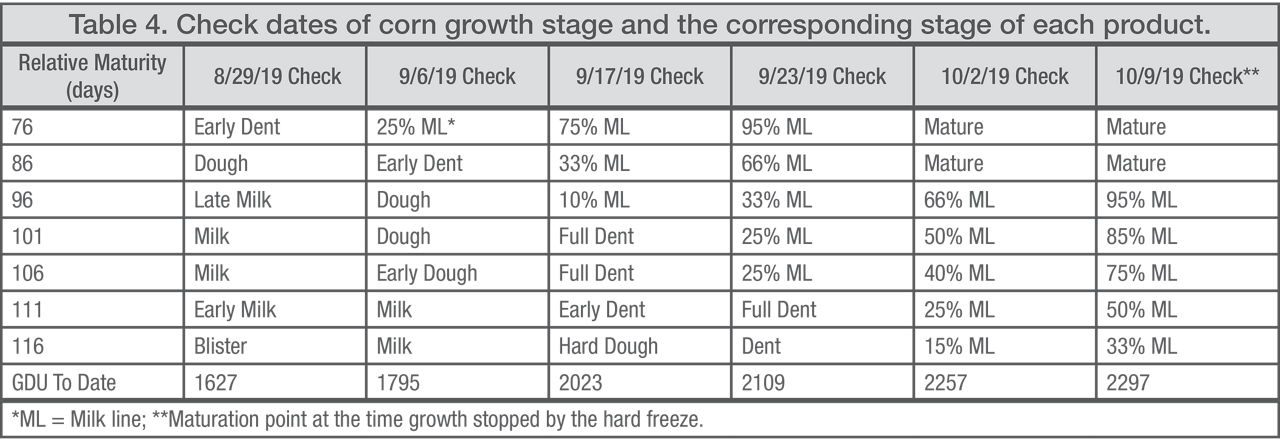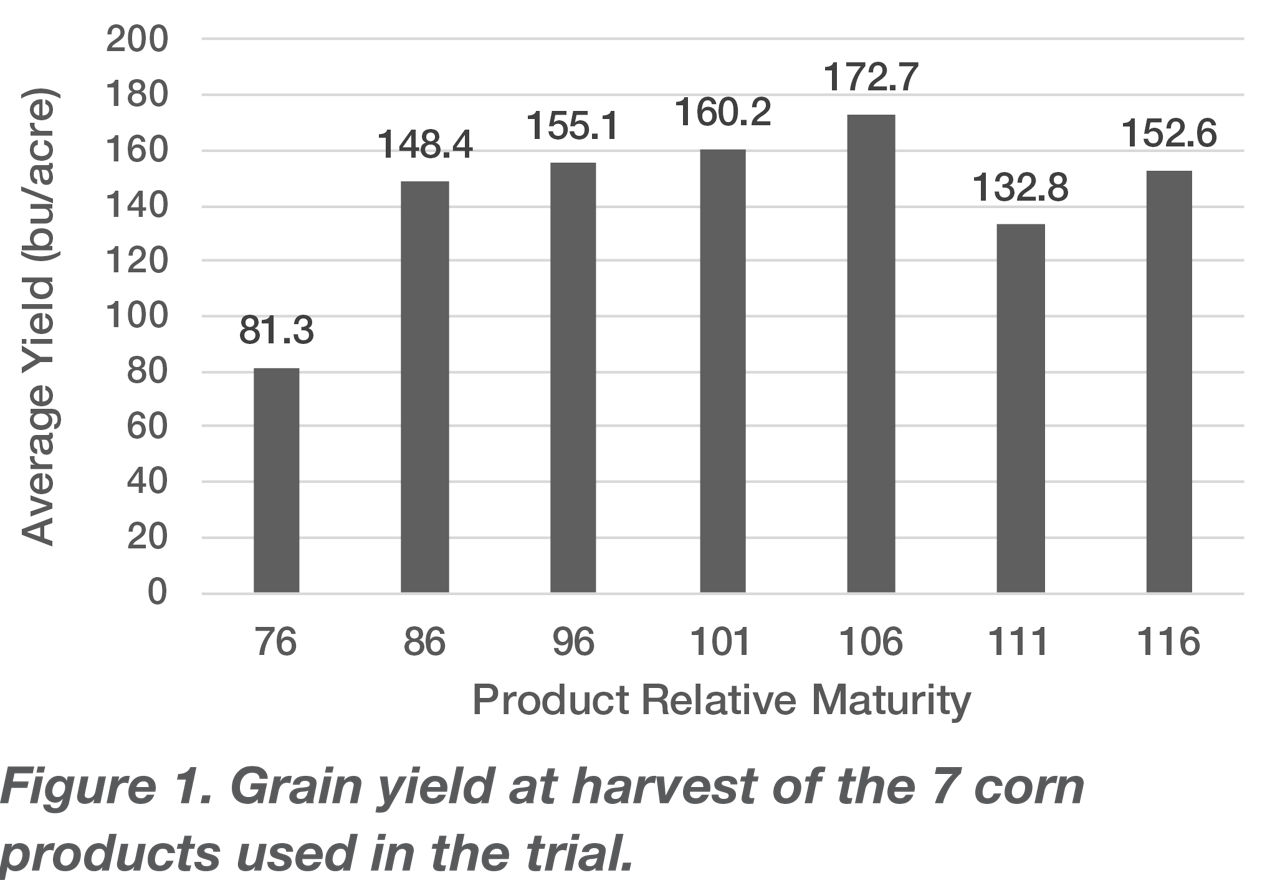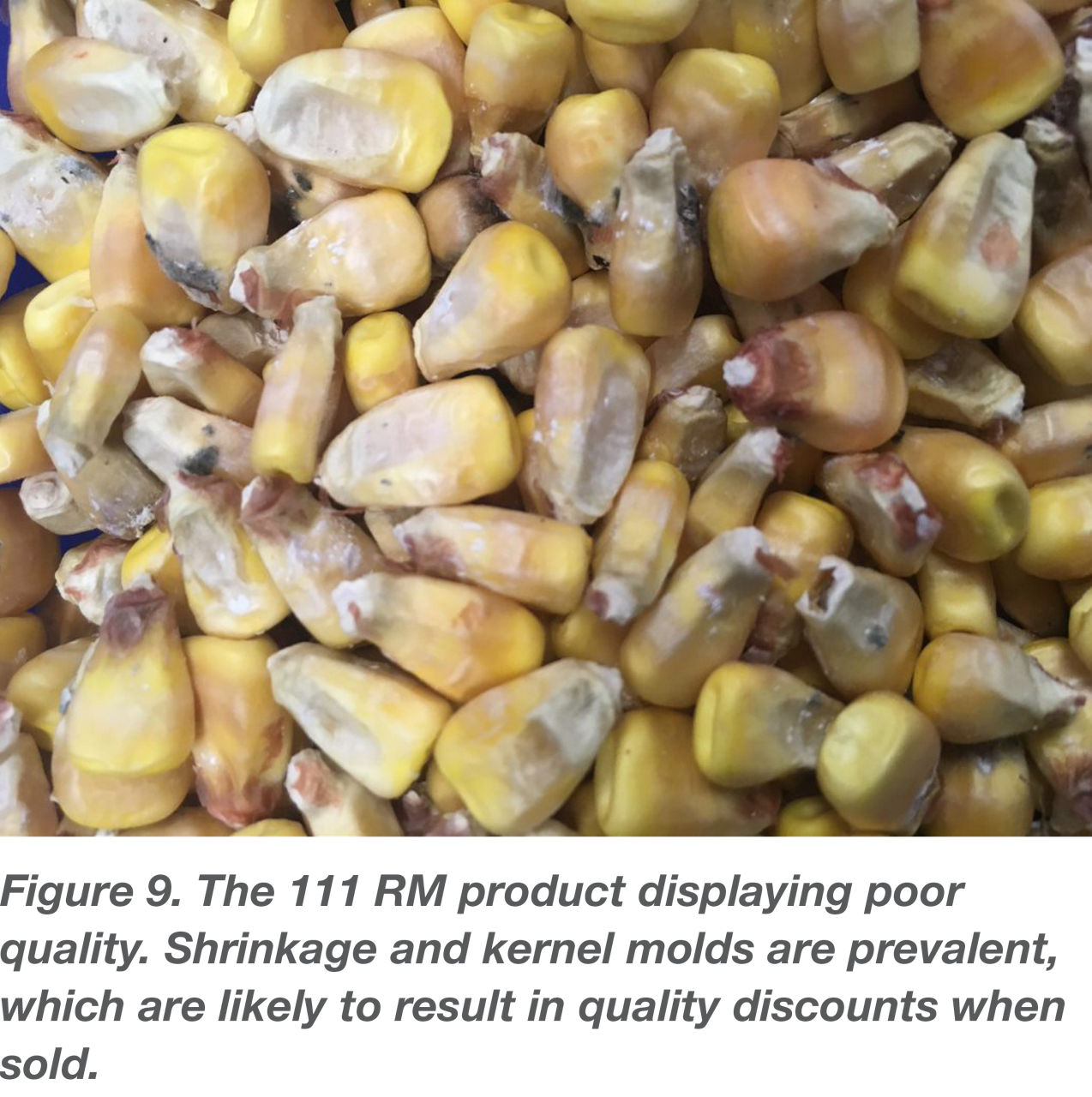Corn Relative Maturities and Response to Delayed Planting
January 10, 2020
TRIAL OBJECTIVE
- A better understanding is needed regarding the response of individual corn products to late planting relative to their number of growing degree units (GDUs) required to reach silking and black layer.
- University publications have indicated that planting late can reduce the number of GDUs required for a corn product to reach black layer.
- This could lead to the ability to plant later relative maturity (RM) corn products than anticipated in a late-planting scenario using standard GDU accumulation estimates.
- This trial measured product performance and grain quality in a late-planted scenario to determine which RM would be the best choice for planting in mid-June.
RESEARCH SITE DETAILS

- The study design was a randomized complete block with three replications of 7 treatments (7 corn products of differing RMs).
- Plot size measured 130 ft long x 10 ft wide with the center 2 rows harvested for data.
- Seven corn products with a wide range of maturities were chosen for the trial.

- Weeds were uniformly controlled with herbicides.
- Fungicides and insecticides were not used in the trial beyond the seed treatment package.
- During the growing season, pollination and black layer (if achieved) dates were recorded for each product.
UNDERSTANDING THE RESULTS
- GDU accumulation for corn planted June 17 was near normal during June, July, and August; above average in September, and finished the growing season about 140 GDUs above normal.
- The trial growing season ended on October 10 with a hard freeze, which was three days ahead of the 30-year normal freeze date of October 13.
- Actual GDUs required to reach mid-pollination ranged from 54 to 95 less than projected, indicating that the crop was on track to finish earlier than the GDU requirements indicated (Table 2).

- Although the results are limited to three products, actual GDUs required to reach black layer ranged from 87 GDUs less to 213 GDUs more than expected to reach black layer (Table 3).

- The 76 RM product, positioned well out of its normal growing zone, required 13 calendar days longer to reach black layer.
- The 86 RM product, positioned closer to its normal growing zone in the Nebraska panhandle, required 4 calendar days longer than expected.
- The 96 RM product, positioned closer to its normal growing zone in the Nebraska panhandle, required 18 fewer calendar days than expected.
- A hard freeze occurred prior to the 101 RM and later RM products reaching black layer.
- Because the freeze killed the plants early, yields and kernel quality were negatively impacted for the later RM products. It’s estimated that corn that freezes at 50% milk line (ML) loses 12% of yield potential with yield losses increasing if the corn freezes at earlier growth stages (Table 4).1


Effect on Yield (Figure 1)
Grain yield generally improved until the product RM reached 106 days and then became more variable.
Even though the 101 and 106 RM products were not mature on the freeze date they still provided more yield than the earlier RM products.
The 111 and 116 RM products froze at earlier growth stages, causing the products to be lower yielding.

Effect on Moisture Content at Harvest (Figure 2)
- The moisture content at harvest was influenced by the RM of each product with the earlier products ready to harvest sooner after the corn froze.
- Harvest dates were 10/26/19 for the 76 and 86 RM products, 11/12/19 for the 96 to 106 RM products, and 11/18/19 for the 111 and 116 RM products.
- The 76 to 106 RM products reached acceptable moisture content by their harvest date.
- The 111 and 116 RM products would require additional drying prior to storage even with a later harvest date.

Effect on Test Weight (Figure 3)
- Test weight was acceptable for all products after drying except for the 111 and 116 RM entries that froze at 50 and 33% milk line, respectively.
- No marketing challenges would be expected because of test weight in the 106 RM and lower RM products in this study.
- The test weight visual inspection of the samples indicates that the grain from the 76 to 106 RM products (Figures 4 to 8) has adequate quality to grade as U.S. No. 1 yellow corn based on test weight.2
- The 111 RM and 116 RM products (Figures 9 and 10, respectively) would pose marketing challenges because the test weight and likely total damage would cause the grain to fall into the U.S. No. 4 yellow corn grade or lower.2







KEY LEARNINGS
- The environment during the growing season plays an important role in the actual response of a corn product to mid-pollination and black layer formation.
- Late-planted corn appears to require less than expected GDUs to reach mid-pollination.
- Due to the limited number of corn products able to reach black layer, it’s difficult to determine the effect of GDU requirement to reach black layer in central Nebraska. However, it did not appear that one can always expect black layer will be reached with fewer GDUs when planting late.
- Yield, harvest date, grain moisture content, and grain quality were all impacted by the product RM at the late planting date; however, a failure to reach black layer did not necessarily make the RM a poor choice.
- The 106 RM product provided the highest yields and acceptable grain quality in this trial, even though it did not reach black layer prior to the end of the growing season.
- It is important to remember that these results occurred with slightly above average GDU accumulation with a planting date of June 17 and a near normal frost date. Changes in GDU accumulation and a change in the frost date could dramatically change the outcome of these results.
Sources
1Frost. 2014. Corn agronomy. Where science meets the field. http://corn.agronomy.wisc.edu/.
2U.S. Standards. Subpart D—United States standards for corn. 1996. United States Department of Agriculture Grain Inspection, Packers and Stockyards Administration Federal Grain Inspection Service. https://www.gipsa.usda.gov/.
3013_R7
Seed Brands & Traits
Crop Protection
Disclaimer
Always read and follow pesticide label directions, insect resistance management requirements (where applicable), and grain marketing and all other stewardship practices.
©2024 Bayer Group. All rights reserved.